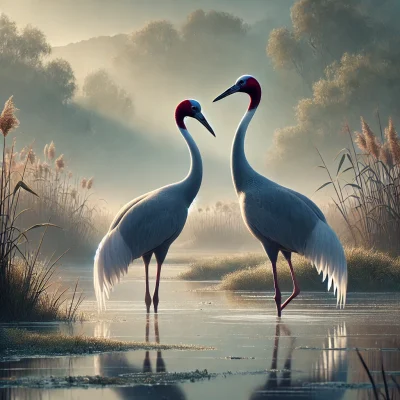10std English Question and Answer Karnataka State Board Syllabus
SSLC English Pome Chapter 1
To a Pair of Sarus Cranes
Scroll Down to Download To a Pair of Sarus Cranes PDF
Comprehension I: To a Pair of Sarus Cranes
Question 1.
The time of the day suggested in the poem is
a. sunrise
b. sunset
c. either sunrise or sunset
d. not clear
Answer:
(a) sunrise
Question 2.
The sun is described as the reluctant sun. It means that
a. the sun was unwilling to rise.
b. the male bird was impatient.
c. it was the bird’s feeling that the sun was reluctant to rise.
d. the sun always takes more time to rise than to set.
Answer:
(a) the sun was unwilling to rise.
Question 3.
In the first 4 lines, there is an exaggeration in the description. What is it?
What figure of speech is used here?
Answer:
The male bird is shown as bending to pluck the sun out from the rim of the horizon. Certainly, the bird cannot touch the sun with its beak or even reach the horizon. The bent neck of the bird and the eager movements of the bird are shown thus.
The figure of speech is Hyperbole.
Question 4.
How was the majestic neck humbled by the hunter?
Answer:
The neck of a Sarus crane is very long, graceful and beautiful. At a time when the bird was stretching its neck and trying to do something impossible like pulling the sun out of the rim of the horizon, the bird was shot in the neck.
When it fell dead, the hunter, without paying any attention to the beauty that was lost through his action, casually picked up the bird’s hands and jaws’, crumpled it like a piece of paper and threw it into his bag without a second look at it. In this manner, the majestic neck has humbled the hunter.
Question 5.
The expression ‘picked up hands and jaws,’ suggests,
a. callousness of the hunters.
b. heartlessness of the hunters.
c. urgency of the hunters.
d. cruelty of the hunters
Answer:
(a) callousness of the hunters
Question 6.
_____________ is compared to ‘dirty linen’ (complete the sentence using the correct option)
a. the proud neck of the birds
b. the dead body of the bird
c. the hands and jaws of the bird.
d. the material of the bag,
Answer:
(b) the dead body of the bird
Question 7.
and sat to hatch/the bloodstained feathers/into a toddling chick’. This suggests,
a. that the female bird was out of her senses after the death of the male bird.
b. the intense love of the female bird towards its male partner.
c. the foolish act of the female bird.
d. the desperate act of the female bird to bring the male bird back to life.
Answer:
(a) that the female bird was out of her senses after the death of the male bird.
Question 8.
How is the end of the female crane suggested in the poem?
Answer:
It is said that a wave of the seas she had never seen came to her and carried her away. It cannot be the real sea because the cranes lived near the sea. It could be a wave of grief that the bird had never known as long as her partner was alive.
She was always very happy, and the death of the male bird pushed her towards sadness. Grieving for the male bird and sitting on his blood-stained feathers, the female bird forgot to eat or drink and thus, becoming very weak, met her end.
Question 9.
A wave of the seas she had never seen came to her from far away and carried her to him.
What does ‘wave of the seas’ refer to?
What hadn’t the female bird seen before?
What figure of speech is used in the extract?
Answer:
A wave of grief.
The female bird hadn’t known grief or sadness before.
Personification.
Comprehension II: To a Pair of Sarus Cranes
Question 1.
How is the callousness of the bird killers brought out in the poem?
Answer:
- The poem brings out a contrast between birds and hunters.
- The male bird is ‘necking.’. The word can be interpreted in two different ways.
- Hunter shoots down a bird and, picking it up, throws it into a washing bag.
- Birds are very graceful and beautiful but the hunter treats them carelessly
- Hunter goes away, but the female bird stays there.
The callousness of the hunters is brought out in the way the poet describes the killing of a male sarus bird. It was shot when the bird had dipped its beak in the water. It seemed like it was trying to pull the reluctant sun out of the water at the rim of the horizon.
The hunters were not touched by the beauty of the bird. They picked up the dead bird by its hands and jaws
and flung it into a course bag as if it were a piece of dirty linen and the bag a washing bag.
Question 2.
How does the poet bring out the agony and desperation of the female crane in the poem?
Answer:
- The female bird flies around crying when the male bird is shot.
- It returns to the spot when the hunter goes away.
- It goes on to express its sorrow to anyone who could understand.
- It sits on the feathers as if to hatch them, forgetting food and drink.
- It finally dies, grieving for its mate.
The cranes pair for life. Having seen its mate shot dead by the hunters and being taken away, the female sarus is heartbroken. The bird circled the sky with grace, mourning over the disgraceful end of its partner. After the killers had left the place, the female bird returned to the death scene and kept flying around whining for its companions with short and long wails resembling the Morse Code.
With her beak, she kissed the bloodstained feathers of her mate, which the wind had not yet carried away, and sat down to hatch them in the hope she could bring him back to life. This shows the agony and the despair of the bird.
Question 3.
Pick out any two figures of speech used in the poem and explain how they add to the effectiveness of the poem.
Answer:
The first stanza of the poem contains a figure of speech—hyperbole—which is used to highlight a particular point through exaggeration. The male Sarus crane is shown as if it is stretching its neck to pull out the sun from the rim of the horizon.
It is shown to be engaged in an impossible act, and yet the very attempt to do it shows the courage of the crane. However, the bird was no match for the cunningness and heartlessness of man.
The second stanza contains the figure of speech ‘simile’—“to’ “lie like dirty linen.”. The proud, dignified bird was killed and thrown into the washing bag like dirty linen. This reveals the callousness and lack of aesthetic sense of the hunter. The beautiful, graceful bird was just a piece of meat for him.
To a Pair of Sarus Cranes Poem Summary
This poem gives us a wonderful, touching account of the love of Sarus cranes. It can be considered an ode to this pair of Sarus cranes because odes celebrate the laudatory qualities of their subjects/The poet gives us a picture of birds where they appear nobler than human beings because their love extends beyond death.
The poem begins with a picture of the main Sarus crane stretching its neck as if to pluck the sun out from the rim of the horizon. The bold initiative of the bird is revealed as it is trying to do the impossible. It is at this wonderful moment that a hunter does the shameful act of shooting down the male bird.
The word ‘necked’ in the first stanza can also be understood as the two birds embracing each other when the hunter breaks their union by shooting at the male bird. Seen either way, it is a very disgraceful end to a very graceful bird. The female bird immediately starts shrieking and circling the sky, without leaving the place.
After the hunter callously picks up the dead bird, throws it carelessly into his washing bag and goes away, the female bird comes down and searches all around the place for the male bird. She goes on crying all the time, expressing her sorrow to all those who could understand her.
In her intense grief, she gathers some blood-stained feathers and sits on them, as if to hatch a chick from them.
As she sits on the feathers without food or drink, desperately trying to give life to them, a wave from the seas which could be an actual wave of the sea or an intense wave of sorrow, overcomes her and kills her.
Thus, the birds go beyond the ornithologist, Hume’s words: They pair for life.
The poem gives a good contrast of the nature of man and bird. The man appears very cruel, mean and unfeeling whereas the birds appear sensitive, loving and humble.

